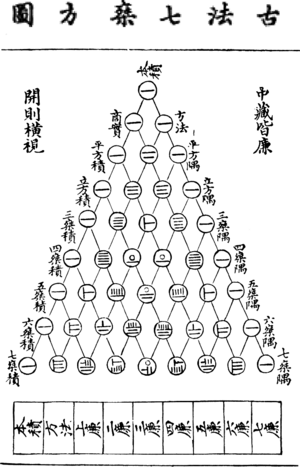Yang Hui facts for kids
Yang Hui (simplified Chinese: 杨辉; traditional Chinese: 楊輝; pinyin: Yáng Huī, around 1238–1298) was a smart Chinese mathematician and writer. He lived during the Song dynasty. His courtesy name was Qianguang (謙光). Yang Hui was from a place called Qiantang, which is now Hangzhou in Zhejiang, China.
He is famous for his work on different math puzzles like magic squares and magic circles. He also studied the binomial theorem, which helps with math problems involving two numbers. Yang Hui is best known for showing the world what we now call Yang Hui's Triangle. This triangle is the same as Pascal's Triangle, but Yang Hui wrote about it much earlier. Another mathematician named Jia Xian actually discovered it before Yang Hui. Yang Hui also lived at the same time as another well-known mathematician, Qin Jiushao.
Contents
Yang Hui's Amazing Math Books
Yang Hui wrote several important math books. These books helped people understand math better during his time.
The Triangle of Numbers
The first known Chinese drawing of what we call 'Pascal's triangle' appeared in Yang Hui's book Xiangjie Jiuzhang Suanfa (詳解九章算法). This book was published in 1261 AD. Yang Hui was honest and said that the way he found square roots and cubic roots using this "Yang Hui's Triangle" was actually invented by an older mathematician named Jia Xian. Jia Xian had explained this method around 1100 AD, which was about 500 years before a French mathematician named Pascal wrote about it.
Jia Xian's original book, called Rújī Shìsuǒ (如積釋鎖), is now lost. But we know about it from another mathematician, Liu Ruxie (劉汝諧). Jia Xian described a special way to list numbers for binomial problems. This method also appeared later in a book by Zhu Shijie in 1303 AD, called Jade Mirror of the Four Unknowns (四元玉鑒).
Puzzles and Patterns: Magic Squares
Around 1275 AD, Yang Hui published two more math books. These were called Xugu Zhaiqi Suanfa (續古摘奇算法) and Suanfa Tongbian Benmo (算法通變本末). The second book is often just called Yang Hui suanfa (楊輝算法).
In the first book, Yang Hui wrote about arranging numbers in magic circles. These are circles where numbers are placed in a special way. He also wrote about magic squares, which are grids where numbers add up to the same total in every row, column, and diagonal. He even gave rules for how to build these amazing puzzles!
Yang Hui's Thoughts on Math
Yang Hui was very modern in his thinking about math. He believed that mathematicians should always explain why their methods work, not just how to use them. He even criticized earlier mathematicians like Li Chunfeng and Liu Yi (劉益). He felt they just used methods without explaining the ideas behind them.
Yang Hui once said:
- The men of old changed the name of their methods from problem to problem, so that as no specific explanation was given, there is no way of telling their theoretical origin or basis.
This shows he wanted math to be clear and easy to understand.
Geometry and Equations
Yang Hui also proved a geometry idea that was very similar to something the Greek mathematician Euclid (who lived around 300 BC) had written. Yang Hui showed that certain parts of a parallelogram are equal to each other. He used a rectangle and a shape called a gnomon to explain this. Many of his geometry ideas were surprisingly like Euclid's system. However, Euclid's books were not translated into Chinese until the early 1600s. This was done by an Italian Jesuit named Matteo Ricci and a Chinese official named Xu Guangqi during the Ming dynasty.
Yang Hui's writings are also the first place where we see quadratic equations that have negative numbers in them. He said that the idea for this came from the earlier mathematician Liu Yi. Yang Hui was also very good at working with decimal numbers. For example, if he wanted to find the area of a field that was 24 paces and 3.4 feet wide, and 36 paces and 2.8 feet long, he would write them as decimals: 24.68 multiplied by 36.56 equals 902.3008. This shows how advanced his math skills were!
See also
 In Spanish: Yang Hui para niños
In Spanish: Yang Hui para niños
- History of mathematics
- List of mathematicians
- Chinese mathematics




